iAmideV-Deep: Valine Amidation Site Prediction in Proteins Using Deep Learning and Pseudo Amino Acid Compositions
Abstract
:1. Introduction
2. Materials and Methods
2.1. Collection of Benchmark Dataset
2.2. Sample Encoding
2.3. Candidate Deep Model Training and Optimization
2.3.1. Standard Neural Network
2.3.2. Recurrent Neural Networks
- For computation, generic LSTM units do not use relevance gate .
- Instead of Update gate , LSTM units use two different gates including Output gate and Forget gate . Output gate monitors the exposure of the memory cell contents to compute activation outputs of LSTM unit for other hidden units in the network. Forget gate manages the amount of overwrite on to achieve , i.e., how much memory cell content needs to be forgotten for memory cell.
- In LSTM, the contents of the memory cell may not be equal to the activation which is contrary to GRU architecture.
2.3.3. Convolutional Neural Network
3. Results
3.1. Precision-Recall Curve and Mean Average Precision
3.2. Receiver Operating Characteristics and Area under ROC
3.3. Accuracy, F1-Score, and Matthew’s Correlation
4. Discussion
4.1. Comparison with Literature
4.2. Deep Feature Space Visualizations
4.3. Model Deployment as Web Service
5. Conclusions
6. Limitation and Future Research
Author Contributions
Funding
Institutional Review Board Statement
Informed Consent Statement
Acknowledgments
Conflicts of Interest
References
- Arkhipenko, S.; Sabatini, M.T.; Batsanov, A.S.; Karaluka, V.; Sheppard, T.D.; Rzepa, H.S.; Whiting, A. Mechanistic insights into boron-catalysed direct amidation reactions. Chem. Sci. 2018, 9, 1058–1072. [Google Scholar] [CrossRef] [Green Version]
- Borah, G.; Borah, P.; Patel, P. Cp* Co (iii)-catalyzed ortho-amidation of azobenzenes with dioxazolones. Org. Biomol. Chem. 2017, 15, 3854–3859. [Google Scholar] [CrossRef] [PubMed]
- Chen, S.; Feng, B.; Zheng, X.; Yin, J.; Yang, S.; You, J. Iridium-catalyzed direct regioselective C4-amidation of indoles under mild conditions. Org. Lett. 2017, 19, 2502–2505. [Google Scholar] [CrossRef]
- Dorr, B.M.; Fuerst, D.E. Enzymatic amidation for industrial applications. Curr. Opin. Chem. Biol. 2018, 43, 127–133. [Google Scholar] [CrossRef]
- Lundberg, H.; Tinnis, F.; Zhang, J.; Algarra, A.G.; Himo, F.; Adolfsson, H. Mechanistic elucidation of zirconium-catalyzed direct amidation. J. Am. Chem. Soc. 2017, 139, 2286–2295. [Google Scholar] [CrossRef] [PubMed]
- Liang, D.; Yu, W.; Nguyen, N.; Deschamps, J.R.; Imler, G.H.; Li, Y.; MacKerell, A.D., Jr.; Jiang, C.; Xue, F. Iodobenzene-Catalyzed Synthesis of Phenanthridinones via Oxidative C–H Amidation. J. Org. Chem. 2017, 82, 3589–3596. [Google Scholar] [CrossRef] [PubMed]
- Mura, M.; Wang, J.; Zhou, Y.; Pinna, M.; Zvelindovsky, A.V.; Dennison, S.R.; Phoenix, D.A. The effect of amidation on the behaviour of antimicrobial peptides. Eur. Biophys. J. 2016, 45, 195–207. [Google Scholar] [CrossRef] [Green Version]
- Wang, T.; Zheng, W.; Wuyun, Q.; Wu, Z.; Ruan, J.; Hu, G.; Gao, J. PrAS: Prediction of amidation sites using multiple feature extraction. Comput. Biol. Chem. 2017, 66, 57–62. [Google Scholar] [CrossRef]
- Ortiz, G.X., Jr.; Hemric, B.N.; Wang, Q. Direct and selective 3-amidation of indoles using electrophilic N-[(benzenesulfonyl) oxy] amides. Org. Lett. 2017, 19, 1314–1317. [Google Scholar] [CrossRef] [Green Version]
- Yu, L.C.; Gu, J.W.; Zhang, S.; Zhang, X. Visible-Light-Promoted Tandem Difluoroalkylation–Amidation: Access to Difluorooxindoles from Free Anilines. J. Org. Chem. 2017, 82, 3943–3949. [Google Scholar] [CrossRef]
- Yu, X.; Yang, S.; Zhang, Y.; Guo, M.; Yamamoto, Y.; Bao, M. Intermolecular amidation of quinoline N-oxides with arylsulfonamides under metal-free conditions. Org. Lett. 2017, 19, 6088–6091. [Google Scholar] [CrossRef]
- Shi, P.; Wang, L.; Chen, K.; Wang, J.; Zhu, J. Co (III)-Catalyzed Enaminone-Directed C–H Amidation for Quinolone Synthesis. Org. Lett. 2017, 19, 2418–2421. [Google Scholar] [CrossRef] [PubMed]
- Rivera, H., Jr.; Dhar, S.; La Clair, J.J.; Tsai, S.C.; Burkart, M.D. An unusual intramolecular trans-amidation. Tetrahedron 2016, 72, 3605–3608. [Google Scholar] [CrossRef] [PubMed] [Green Version]
- Naseer, S.; Hussain, W.; Khan, Y.D.; Rasool, N. iPhosS(Deep)-PseAAC: Identify Phosphoserine Sites in Proteins using Deep Learning on General Pseudo Amino Acid Compositions via Modified 5-Steps Rule. IEEE/ACM Trans. Comput. Biol. Bioinform. 2020, 1. [Google Scholar] [CrossRef] [PubMed]
- Khan, Y.D.; Rasool, N.; Hussain, W.; Khan, S.A.; Chou, K.C. iPhosT-PseAAC: Identify phosphothreonine sites by incorporating sequence statistical moments into PseAAC. Anal. Biochem. 2018, 550, 109–116. [Google Scholar] [CrossRef] [PubMed]
- Butt, A.H.; Rasool, N.; Khan, Y.D. Predicting membrane proteins and their types by extracting various sequence features into Chou’s general PseAAC. Mol. Biol. Rep. 2018, 45, 2295–2306. [Google Scholar] [CrossRef] [PubMed]
- Naseer, S.; Hussain, W.; Khan, Y.D.; Rasool, N. Sequence-based Identification of Arginine Amidation Sites in Proteins Using Deep Representations of Proteins and PseAAC. Curr. Bioinform. 2021, 15, 937–948. [Google Scholar] [CrossRef]
- Akmal, M.A.; Rasool, N.; Khan, Y.D. Prediction of N-linked glycosylation sites using position relative features and statistical moments. PLoS ONE 2017, 12, e0181966. [Google Scholar] [CrossRef] [Green Version]
- Butt, A.H.; Rasool, N.; Khan, Y.D. A Treatise to Computational Approaches Towards Prediction of Membrane Protein and Its Subtypes. J. Membr. Biol. 2017, 250, 55–76. [Google Scholar] [CrossRef] [PubMed]
- Naseer, S.; Hussain, W.; Khan, Y.D.; Rasool, N. NPalmitoylDeep-PseAAC: A Predictor for N-Palmitoylation sites in Proteins using Deep Representations of Proteins and PseAAC via modified 5-steps rule. Curr. Bioinform. 2020, 15. [Google Scholar] [CrossRef]
- Hussain, W.; Khan, Y.D.; Rasool, N.; Khan, S.A.; Chou, K.C. SPalmitoylC-PseAAC: A sequence-based model developed via Chou’s 5-steps rule and general PseAAC for identifying S-palmitoylation sites in proteins. Anal. Biochem. 2019, 568, 14–23. [Google Scholar] [CrossRef]
- Song, J.; Wang, Y.; Li, F.; Akutsu, T.; Rawlings, N.D.; Webb, G.I.; Chou, K.C. iProt-Sub: A comprehensive package for accurately mapping and predicting protease-specific substrates and cleavage sites. Briefings Bioinform. 2019, 20, 638–658. [Google Scholar] [CrossRef] [Green Version]
- Zhao, S.; Yu, H.; Gong, X. Predicting protein amidation sites by orchestrating amino acid sequence features. JPhCS 2017, 887, 012052. [Google Scholar] [CrossRef] [Green Version]
- Yau, S.S.T.; Yu, C.; He, R. A Protein Map and Its Application. DNA Cell Biol. 2008, 27, 241–250. [Google Scholar] [CrossRef]
- Yu, C.; Cheng, S.Y.; He, R.L.; Yau, S.S.T. Protein map: An alignment-free sequence comparison method based on various properties of amino acids. Gene 2011, 486, 110–118. [Google Scholar] [CrossRef] [PubMed]
- Goodfellow, I.; Bengio, Y.; Courville, A. Deep Learning; MIT Press: Cambridge, MA, USA, 2016. [Google Scholar]
- Krizhevsky, A.; Sutskever, I.; Hinton, G.E. ImageNet Classification with Deep Convolutional Neural Networks. In Advances in Neural Information Processing Systems 25; Pereira, F., Burges, C.J.C., Bottou, L., Weinberger, K.Q., Eds.; Curran Associates, Inc.: Red Hook, NY, USA, 2012; pp. 1097–1105. [Google Scholar]
- Muneer, A.; Fati, S.M. Efficient and Automated Herbs Classification Approach Based on Shape and Texture Features using Deep Learning. IEEE Access 2020, 8, 196747–196764. [Google Scholar] [CrossRef]
- Sutskever, I.; Vinyals, O.; Le, Q.V. Sequence to sequence learning with neural networks. arXiv 2014, arXiv:1409.3215. [Google Scholar]
- Naseer, S.; Saleem, Y. Enhanced Network Intrusion Detection using Deep Convolutional Neural Networks. KSII Trans. Internet Inf. Syst. 2018, 12. [Google Scholar] [CrossRef]
- Naseer, S.; Ali, R.F.; Dominic, P.D.D.; Saleem, Y. Learning Representations of Network Traffic Using Deep Neural Networks for Network Anomaly Detection: A Perspective towards Oil and Gas IT Infrastructures. Symmetry 2020, 12, 1882. [Google Scholar] [CrossRef]
- LeCun, Y.; Bengio, Y.; Hinton, G. Deep learning. Nature 2015, 521, 436. [Google Scholar] [CrossRef]
- Chou, K.C. Using subsite coupling to predict signal peptides. Protein Eng. 2001, 14, 75–79. [Google Scholar] [CrossRef] [PubMed] [Green Version]
- Chou, K.C. Some remarks on protein attribute prediction and pseudo amino acid composition. J. Theor. Biol. 2011, 273, 236–247. [Google Scholar] [CrossRef] [PubMed]
- Cheng, X.; Xiao, X.; Chou, K.C. pLoc-mEuk: Predict subcellular localization of multi-label eukaryotic proteins by extracting the key GO information into general PseAAC. Genomics 2018, 110, 50–58. [Google Scholar] [CrossRef]
- Cheng, X.; Xiao, X.; Chou, K.C. pLoc-mHum: Predict subcellular localization of multi-location human proteins via general PseAAC to winnow out the crucial GO information. Bioinformatics 2017, 34, 1448–1456. [Google Scholar] [CrossRef]
- Jia, J.; Li, X.; Qiu, W.; Xiao, X.; Chou, K.C. iPPI-PseAAC (CGR): Identify protein-protein interactions by incorporating chaos game representation into PseAAC. J. Theor. Biol. 2019, 460, 195–203. [Google Scholar] [CrossRef] [PubMed]
- Wang, J.; Li, J.; Yang, B.; Xie, R.; Marquez-Lago, T.T.; Leier, A.; Hayashida, M.; Akutsu, T.; Zhang, Y.; Chou, K.C. Bastion3: A two-layer ensemble predictor of type III secreted effectors. Bioinformatics 2018, 35, 2017–2028. [Google Scholar] [CrossRef] [Green Version]
- Xiao, X.; Cheng, X.; Su, S.; Mao, Q.; Chou, K.C. pLoc-mGpos: Incorporate key gene ontology information into general PseAAC for predicting subcellular localization of Gram-positive bacterial proteins. Nat. Sci. 2017, 9, 330. [Google Scholar] [CrossRef] [Green Version]
- Naseer, S.; Hussain, W.; Khan, Y.D.; Rasool, N. Optimization of serine phosphorylation prediction in proteins by comparing human engineered features and deep representations. Anal. Biochem. 2021, 615, 114069. [Google Scholar] [CrossRef]
- The UniProt Consortium. UniProt: A worldwide hub of protein knowledge. Nucleic Acids Res. 2019, 47, D506–D515. [Google Scholar] [CrossRef] [PubMed] [Green Version]
- Chou, K.C. Prediction of signal peptides using scaled window. Peptides 2001, 22, 1973–1979. [Google Scholar] [CrossRef]
- Vacic, V.; Iakoucheva, L.M.; Radivojac, P. Two Sample Logo: A graphical representation of the differences between two sets of sequence alignments. Bioinformatics 2006, 22, 1536–1537. [Google Scholar] [CrossRef] [Green Version]
- Bergstra, J.; Bengio, Y. Random search for hyper-parameter optimization. J. Mach. Learn. Res. 2012, 13, 305. [Google Scholar]
- Bengio, Y.; Simard, P.; Frasconi, P. Learning Long-Term Dependencies with Gradient Descent is Difficult. IEEE Trans. Neural Netw. 1994, 5, 157–166. [Google Scholar] [CrossRef] [PubMed]
- Rumelhart, D.E.; Hinton, G.E.; Williams, R.J. Learning representations by back-propagating errors. Nature 1986, 323, 533. [Google Scholar] [CrossRef]
- Cho, K.; Van Merriënboer, B.; Bahdanau, D.; Bengio, Y. On the properties of neural machine translation: Encoder-decoder approaches. arXiv 2014, arXiv:1409.1259. [Google Scholar]
- Hochreiter, S.; Schmidhuber, J. Long Short-Term Memory. Neural Comput. 1997, 9, 1735–1780. [Google Scholar] [CrossRef]
- Saito, T.; Rehmsmeier, M. The Precision-Recall Plot Is More Informative than the ROC Plot When Evaluating Binary Classifiers on Imbalanced Datasets. PLoS ONE 2015, 10, e0118432. [Google Scholar] [CrossRef] [Green Version]
- Lasko, T.A.; Bhagwat, J.G.; Zou, K.H.; Ohno-Machado, L. The use of receiver operating characteristic curves in biomedical informatics. J. Biomed. Inform. 2005, 38, 404–415. [Google Scholar] [CrossRef] [Green Version]
- Fawcett, T. An introduction to ROC analysis. Pattern Recognit. Lett. 2006, 27, 861–874. [Google Scholar] [CrossRef]
- DeLong, E.R.; DeLong, D.M.; Clarke-Pearson, D.L. Comparing the areas under two or more correlated receiver operating characteristic curves: A nonparametric approach. Biometrics 1988, 44, 837–845. [Google Scholar] [CrossRef]
- Sun, X.; Xu, W. Fast Implementation of DeLong’s Algorithm for Comparing the Areas Under Correlated Receiver Operating Characteristic Curves. IEEE Signal Process. Lett. 2014, 21, 1389–1393. [Google Scholar] [CrossRef]
- Chicco, D.; Jurman, G. The advantages of the Matthews correlation coefficient (MCC) over F1 score and accuracy in binary classification evaluation. BMC Genom. 2020, 21, 6. [Google Scholar] [CrossRef] [PubMed] [Green Version]
- Maaten, L.V.D.; Hinton, G. Visualizing data using t-SNE. J. Mach. Learn. Res. 2008, 9, 2579–2605. [Google Scholar]



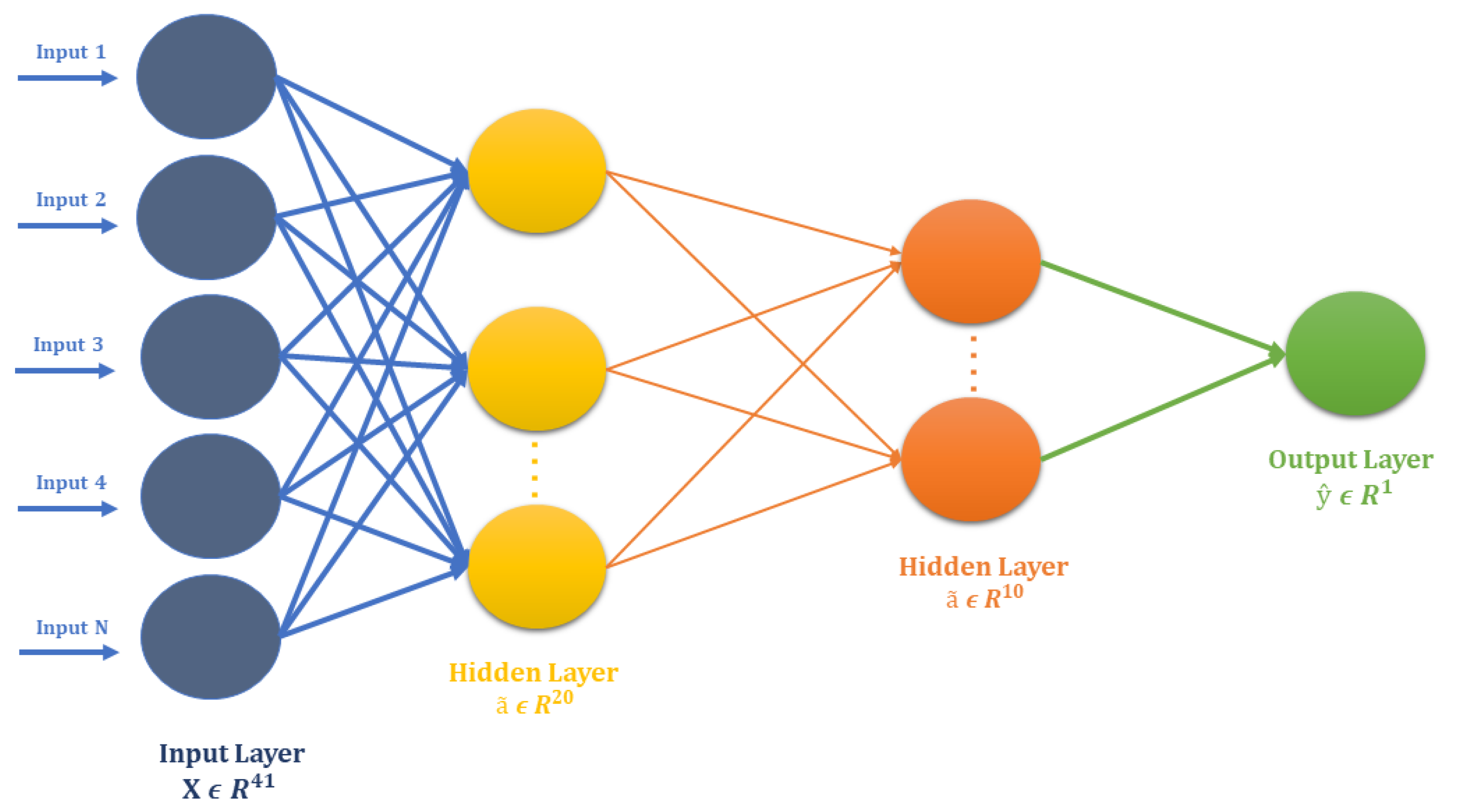
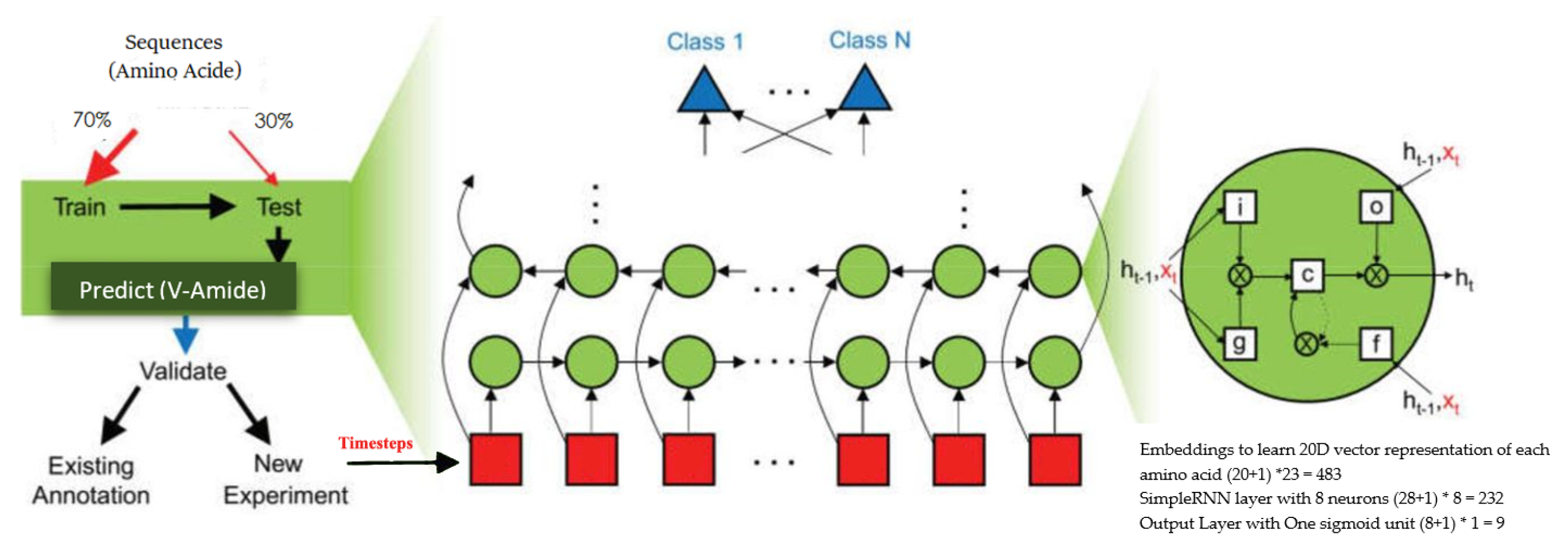

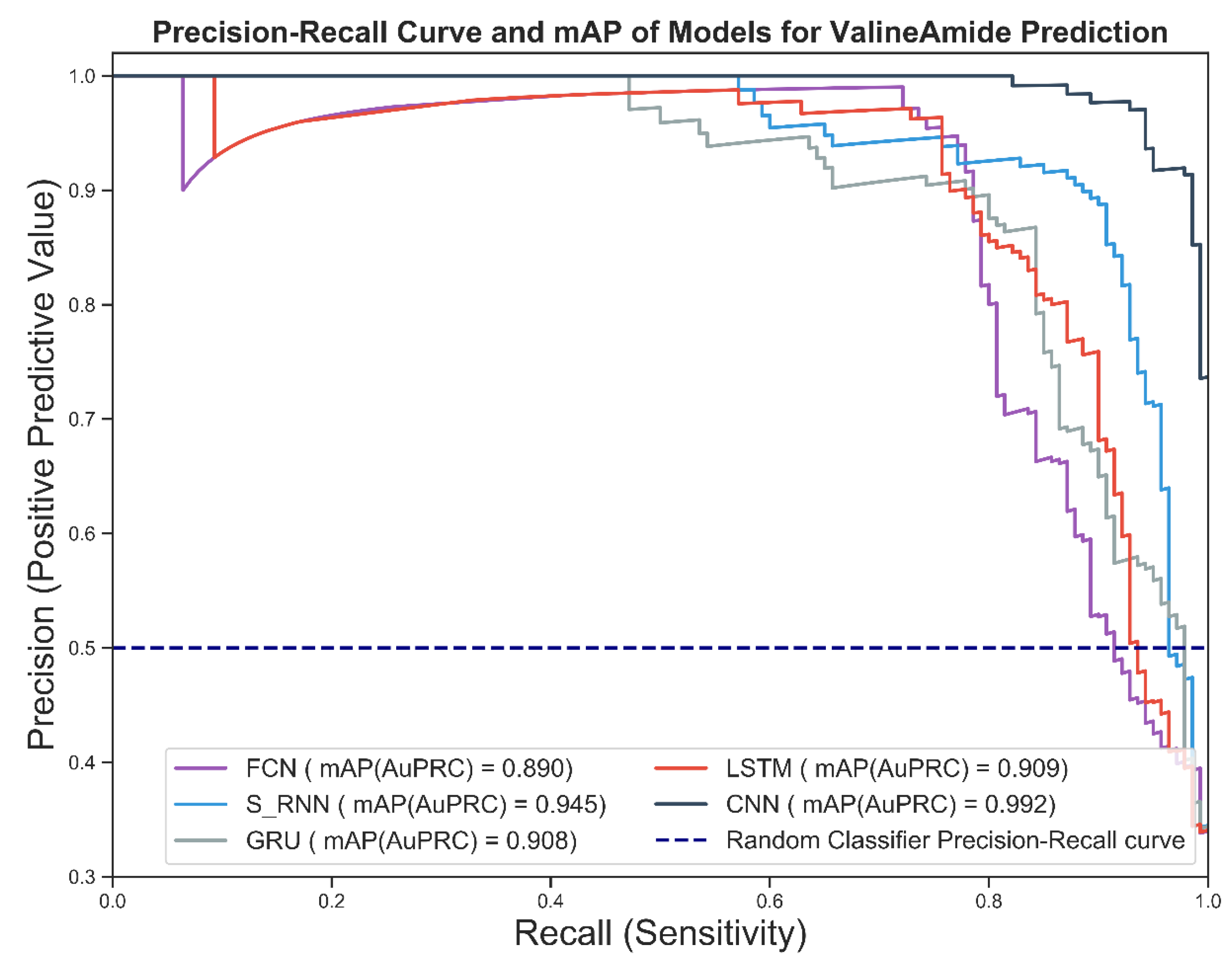
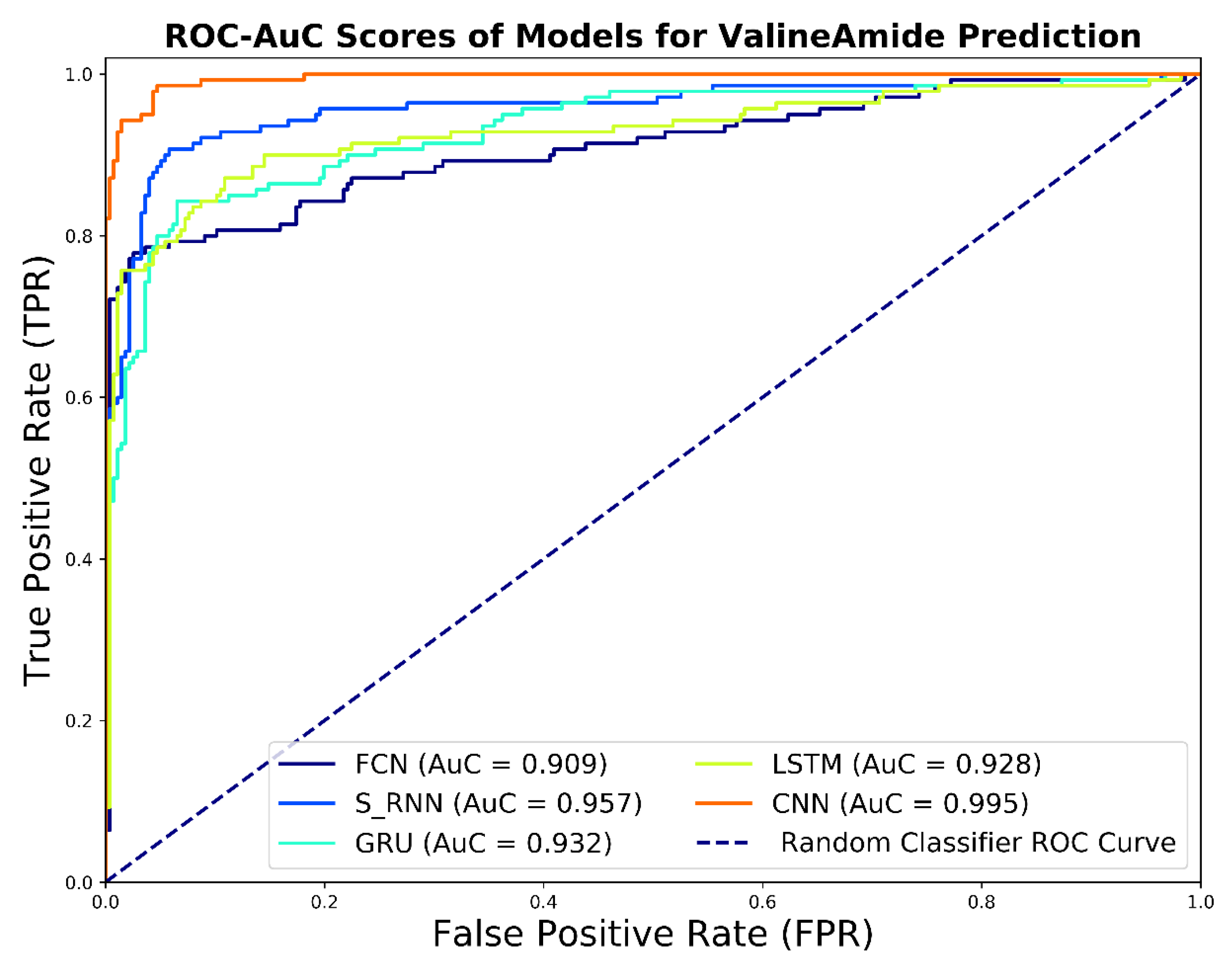

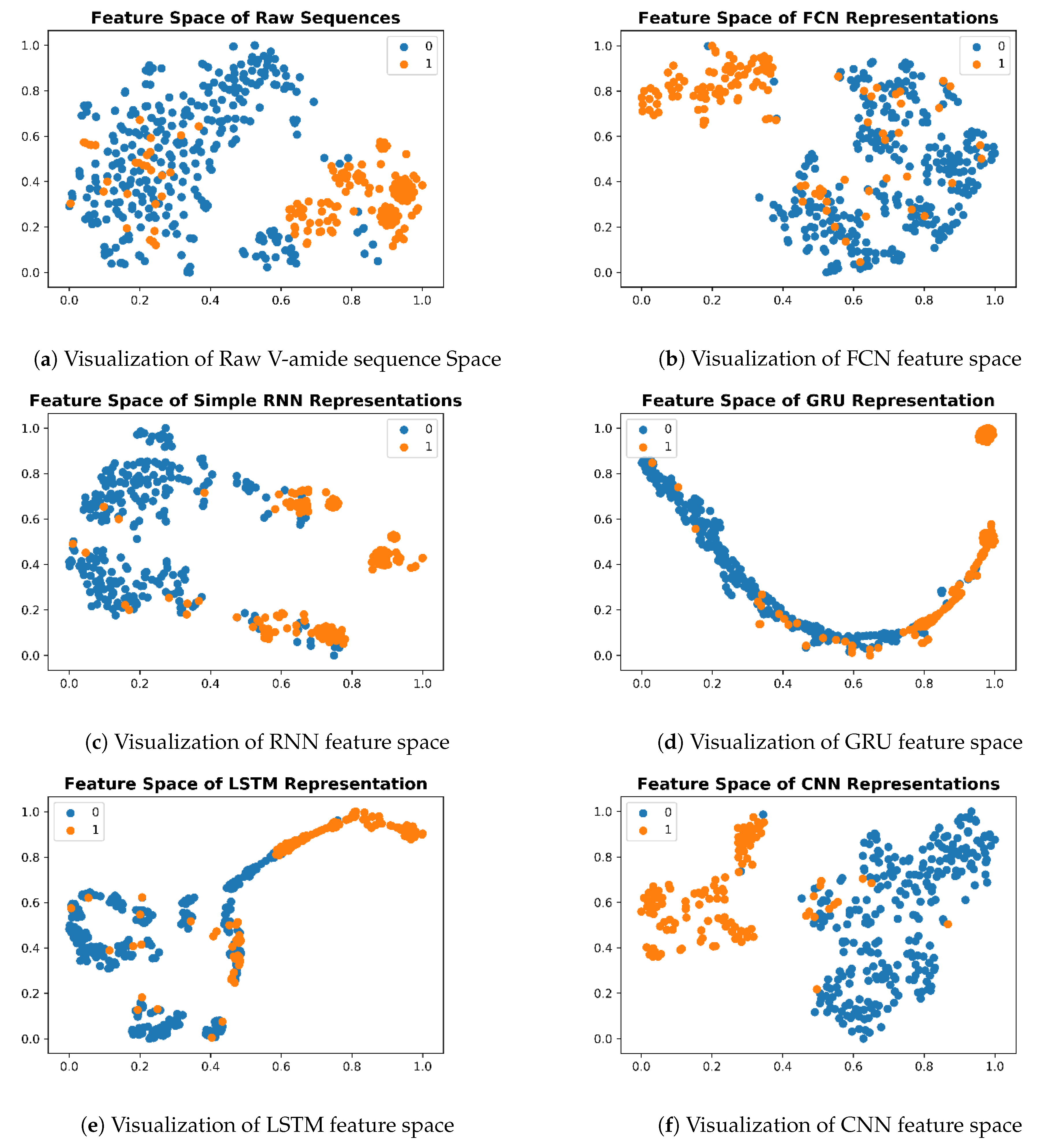
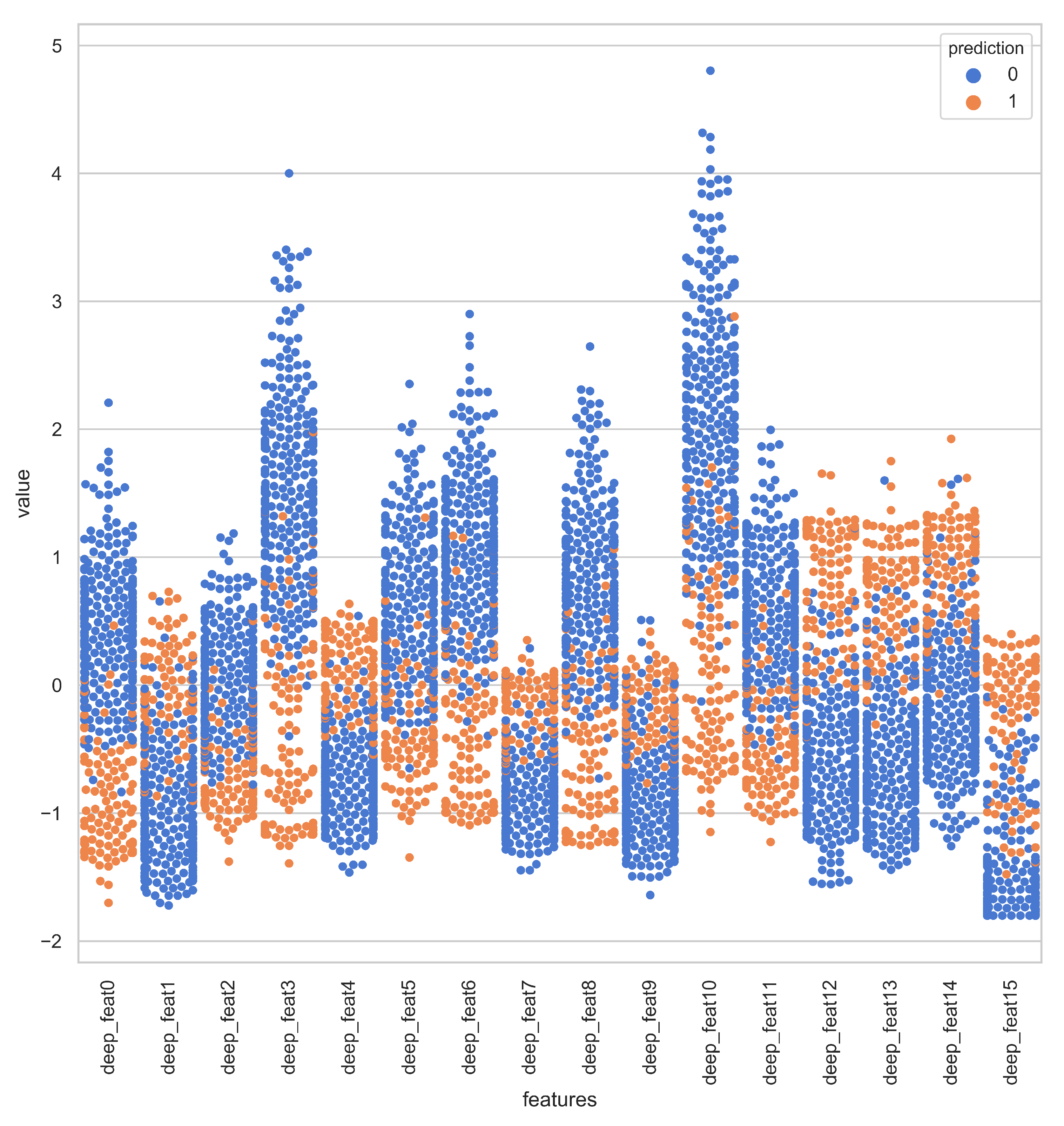
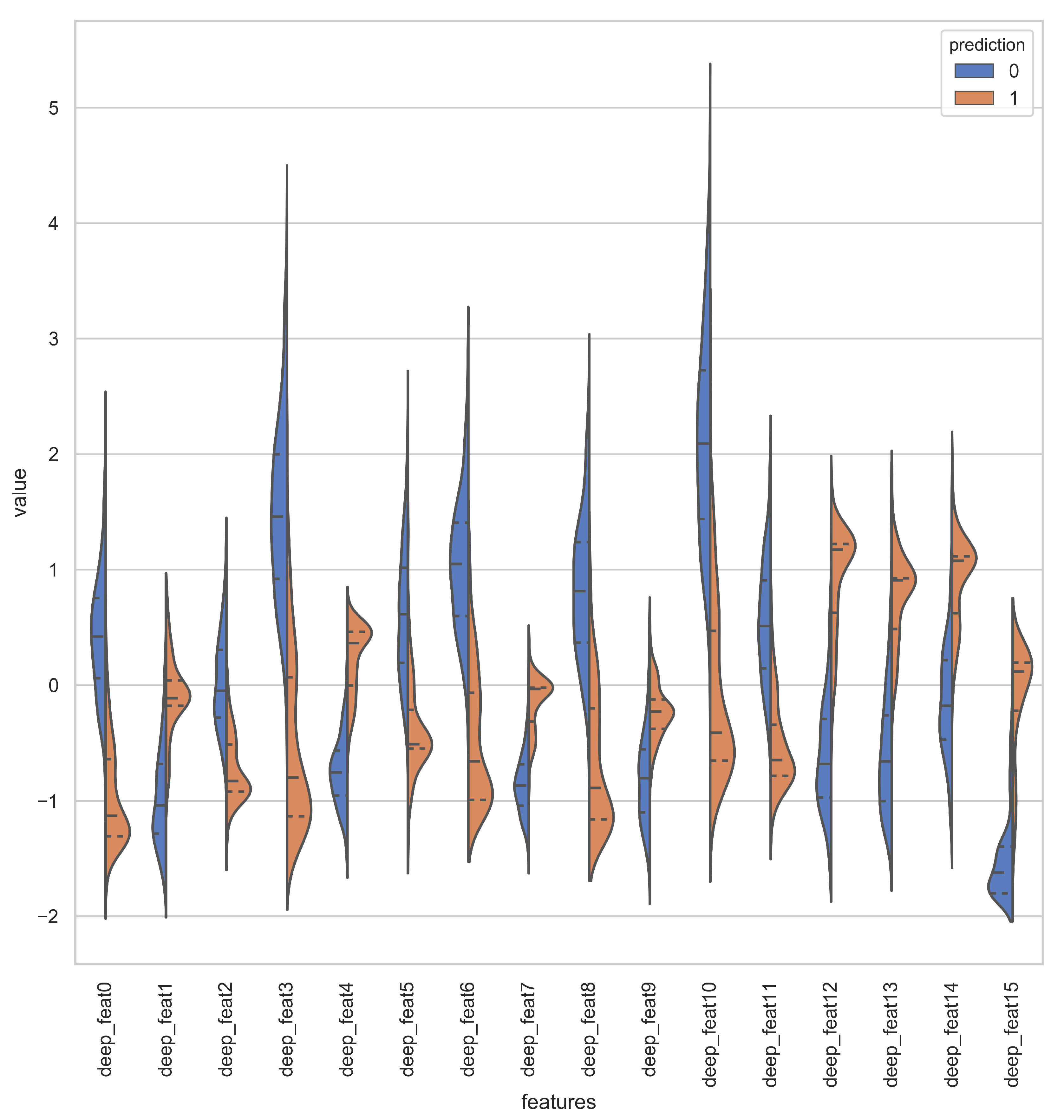
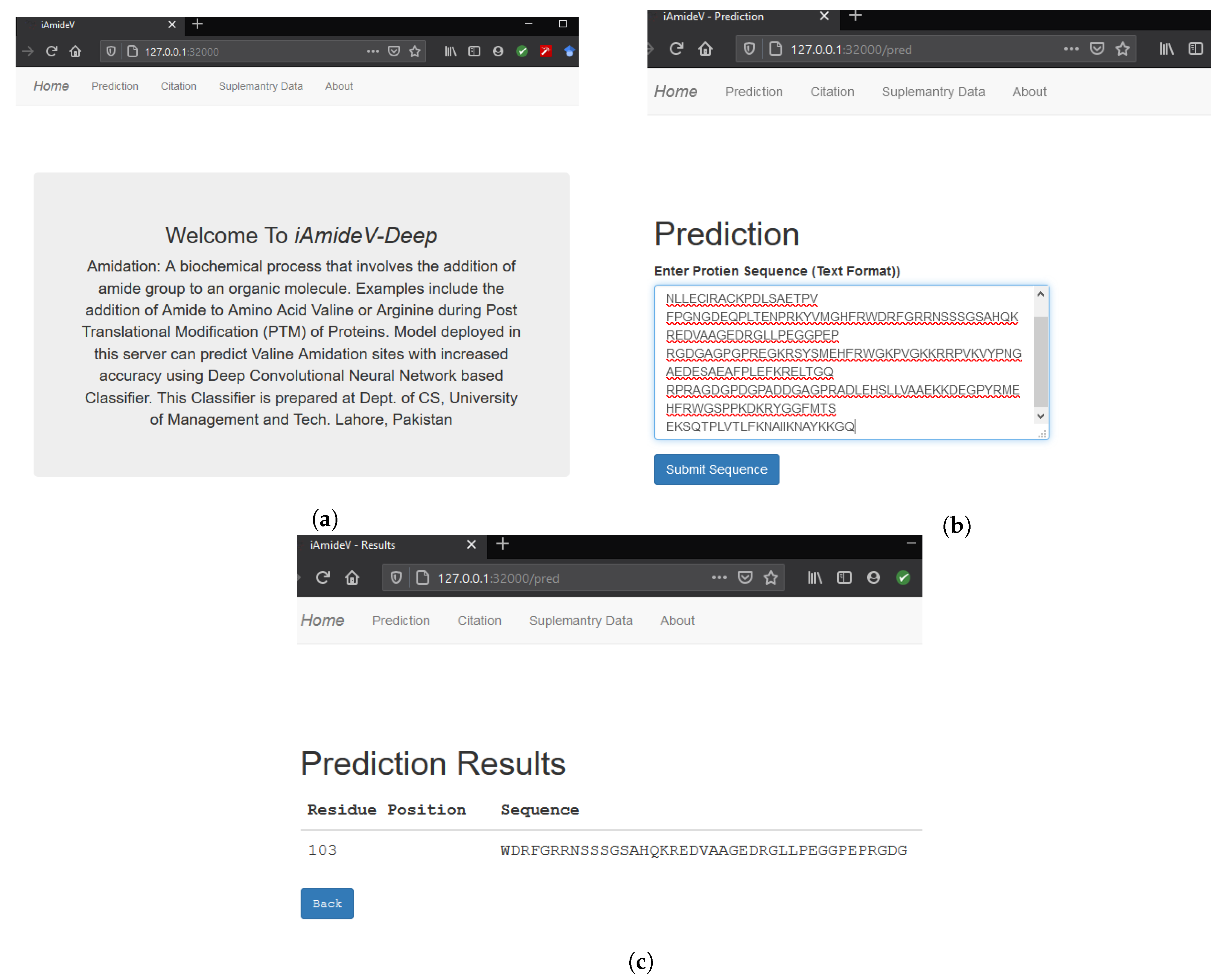
| X | A | C | D | E | F | G | H | I | K | L | M | N | O | P | Q | R | S | T | U | V | W | Y |
|---|---|---|---|---|---|---|---|---|---|---|---|---|---|---|---|---|---|---|---|---|---|---|
| 0 | 1 | 2 | 3 | 4 | 5 | 6 | 7 | 8 | 9 | 10 | 11 | 12 | 13 | 14 | 15 | 16 | 17 | 18 | 19 | 20 | 21 | 22 |
| Type of Neuron Layer | No. of Weights |
|---|---|
| Dense layer with 20 relu units | (41 + 1) × 20 = 840 |
| Dense layer with 10 relu units | (20 + 1) × 10 = 210 |
| Model Output layer with one Sigmoid unit | (10 + 1) × 1 = 11 |
| Type of Neuron Layer | No. of Weights |
|---|---|
| Embeddings to learn 20D vector representation of each amino acid | (20 + 1) × 23 = 483 |
| SimpleRNN layer with 8 neurons | (28 + 1) × 8 = 232 |
| Output Layer with One sigmoid unit | (8 + 1) × 1 = 9 |
| Type of Neuron Layer | No. of Weights |
|---|---|
| Embeddings to learn 20-D vector representation of each amino acid | (20 + 1) × 23 = 483 |
| GRU units layer with 8 neurons | (86 + 1)× 8 = 696 |
| Output Layer with One Sigmoid neuron | (8 + 1) × 1 = 9 |
| Type of Neuron Layer | No. of Weights |
|---|---|
| Embeddings to learn 20-D vector representation of each amino acid | (20 + 1)× 23 = 483 |
| LSTM unit layer with 8 neurons | (115 + 1) × 8 = 928 |
| Output Layer with One Sigmoid neuron | (8 + 1) × 1 = 9 |
| Type of Neuron Layer | No. of Weights |
|---|---|
| Embeddings to learn 20-D vector representation of each amino acid | (20 + 1) × 23 = 483 |
| Conv-1D with 6 kernels of size 3 | ((3 × 20) + 1) × 6 = 366 |
| Maxpool-1D | No weights |
| Regularisation with 25% of probability | No weights |
| Conv-1D with 16 kernels of size 3 | ((3 × 6) + 1) × 16 = 304 |
| Maxpool-1D | No weights |
| GlobalAveragePooling 1D | No weights |
| Output Layer with One Sigmoid neuron | (8 + 1) × 1 = 9 |
| Prediction Model | Area under Curve | 95%CI | p-Value of DeLong Test | Accuracy% |
|---|---|---|---|---|
| Proposed CNN Predictor | 0.995 | [0.991–0.999] | 95.9 | |
| Proposed FCN Predictor | 0.909 | [0.87–0.94] | 90.4 | |
| Proposed SRNN Predictor | 0.957 | [0.93–0.98] | 0.0016 | 92.3 |
| Proposed GRU Predictor | 0.931 | [0.90–0.96] | 89.9 | |
| Proposed LSTM Predictor | 0.927 | [0.89–0.96] | 89.4 | |
| Wang et al. [8] | 0.96 | Not Reported | Not Reported | 92.1 |
| Zhao et al. [23] | 0.964 | Not Reported | Not Reported | 94.2 |
Publisher’s Note: MDPI stays neutral with regard to jurisdictional claims in published maps and institutional affiliations. |
© 2021 by the authors. Licensee MDPI, Basel, Switzerland. This article is an open access article distributed under the terms and conditions of the Creative Commons Attribution (CC BY) license (http://creativecommons.org/licenses/by/4.0/).
Share and Cite
Naseer, S.; Ali, R.F.; Muneer, A.; Fati, S.M. iAmideV-Deep: Valine Amidation Site Prediction in Proteins Using Deep Learning and Pseudo Amino Acid Compositions. Symmetry 2021, 13, 560. https://doi.org/10.3390/sym13040560
Naseer S, Ali RF, Muneer A, Fati SM. iAmideV-Deep: Valine Amidation Site Prediction in Proteins Using Deep Learning and Pseudo Amino Acid Compositions. Symmetry. 2021; 13(4):560. https://doi.org/10.3390/sym13040560
Chicago/Turabian StyleNaseer, Sheraz, Rao Faizan Ali, Amgad Muneer, and Suliman Mohamed Fati. 2021. "iAmideV-Deep: Valine Amidation Site Prediction in Proteins Using Deep Learning and Pseudo Amino Acid Compositions" Symmetry 13, no. 4: 560. https://doi.org/10.3390/sym13040560
APA StyleNaseer, S., Ali, R. F., Muneer, A., & Fati, S. M. (2021). iAmideV-Deep: Valine Amidation Site Prediction in Proteins Using Deep Learning and Pseudo Amino Acid Compositions. Symmetry, 13(4), 560. https://doi.org/10.3390/sym13040560








